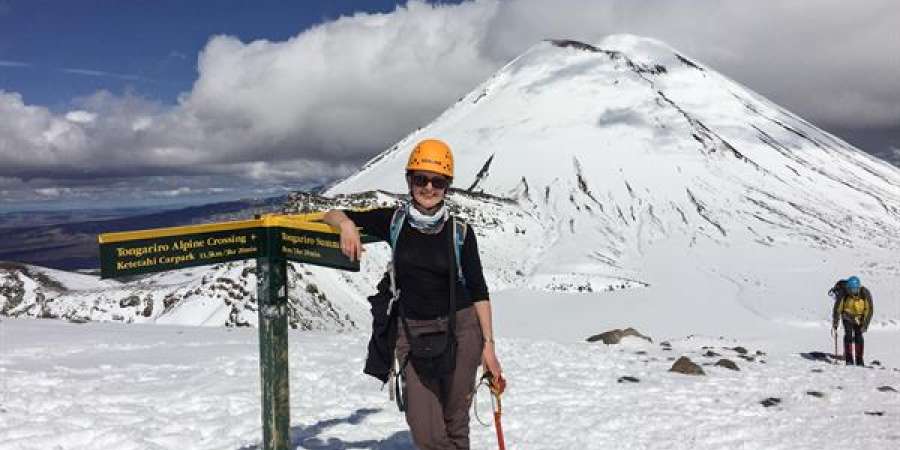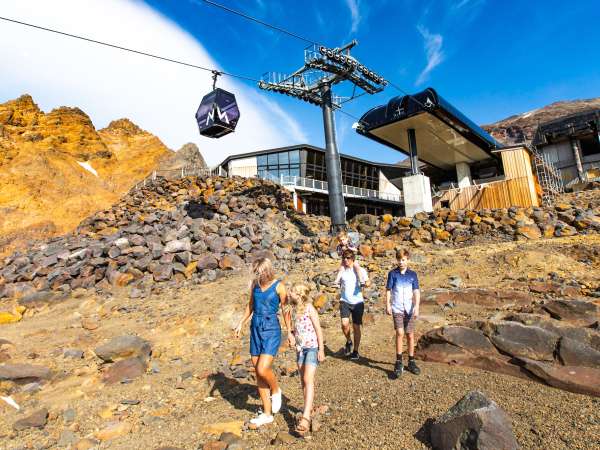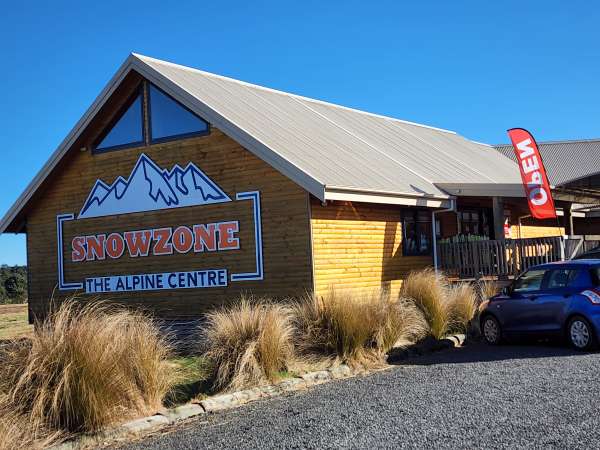A First-Timers Thoughts On Hiking The Tongariro Alpine Crossing In Winter
By Marina van Wyk, Tongariro Crossing Lodge.

By Marina van Wyk, Tongariro Crossing Lodge
The moment the guiding company's van arrived to pick me up from the doorstep of our lodge, I knew I was set for a true alpine adventure.
I had always wanted to do the Tongariro Alpine Crossing in winter and when the opportunity arose recently, I jumped at it.
Everything was aligned - after days of snowfall, a beautiful sunny day was on the cards; I was able to clear my schedule; and local guide operator, Adventure Outdoors, had a free spot for me.
The Adventure Outdoors van arrived on the dot at 7 am to collect me, and after picking up the rest of the group from their accommodation in National Park Village, we were on our way.
During the drive to the start of the hike, the first task for our guides was to ensure everyone was equipped correctly - and whether their clothing was up to scratch for the icy conditions on the trail.
The Adventure Outdoors team gently, yet firmly, requested anyone who turned up wearing jeans or cotton pants, despite being advised otherwise beforehand, to change into proper outdoors clothing.
“It’s ok, I’m happy to wear these pants," says one of the guys in the group, to which the guide responded politely: “I know you are, but I’m not happy with you wearing those pants on the hike.”
A Real Alpine Adventure
Having the guides pass around the specialist gear we would need for the hike, felt like Christmas! We were each fitted individually for crampons and helmets, and when we arrived at the start of the track, were given an ice axe, with instructions on how to carry it with your backpack.
Once we set off - all kitted out - from the Mangatepopo carpark, we all looked like real alpinists and it felt like a real adventure was about to begin!
Heading into the first part of the track through Mangatepopo Valley, I was in awe of the stillness and beauty of the surroundings with snow on the track and everywhere around us. As the narrow path weaves through the valley, along high rocks and streams, you can feel you're entering a special place. The sun still rising from behind the mountains, reflecting like glitter on the untouched white snow, added something magical to the moment. Having done the Crossing twice before in non-winter conditions, I was struck at how different everything looked in the winter conditions.
Halfway through the valley, our guides, Andrea and Doug, split us into two groups, which was great as it made it far easier to hear their instructions and stories as we were walking. The stories they told really helped us to understand and appreciate the unique cultural and natural heritage of the Tongariro National Park. We learnt about verglas, a thin coating of glaze ice, on the track and its formation, stories of Maori tribal wars in the area and the special significance of the Park as the first national park in New Zealand.
The next section of the Crossing is the first where your fitness is tested by a climb, called Devil’s Staircase. It has that name for a reason! Here you climb from 1400 to 1600 meters above sea level, using stairs, which in winter conditions are covered in snow. This was our first opportunity to use the ice axe, although mainly leaning on during the climb. This was a great help, as in my excitement preparing for the hike, I completely forgot to bring my walking sticks with me. With no wind in the air and in full sun, we soon realised what the guides meant when they said it’s going to be hot! Huffing and puffing, with some stops to catch our breath and utter ‘wow’ at the sight of the beautiful Mangatepopo Valley below us and the limitless horizon, we made it to the top in about 30 minutes.
Unique Volcanic Surroundings
Once on top, you find yourself up close and personal with Mt Ngauruhoe rising above you on one side and Mt Tongariro on the other. Doug gave as a good rundown of the different types of past volcanic eruptions, showing us the traces they left on the slopes of Mt Ngauruhoe and they valley below us, helping us appreciate the volcanic nature of the surroundings.
Next was walking along the big plateau of the South Crater. This is an easy part of the Crossing as it's completely flat. Again, I was amazed at the contrast between how this area looked in winter to what I was familiar with. Usually a flat-as-a-pancake sandy and rocky plain, it was all completely covered under a thick layer of snow. Even the track marker posts, which are usually hip-high, only stuck out about 10 cm above the snow. With the sun reflecting from the snow and no wind, I ended-up with an unexpected t-shirt sun tan from this section!
From the South Crater plateau to the next landmark, the Red Crater, was another steep climb onto a ridge, which was also covered in snow. Here Andrea and Doug had to decide whether we needed crampons, but since the snow was soft enough, we didn't after all.
The view from the ridge over the eastern part of the Park and beyond to the Kaimanawa Ranges always takes your breath away! Andrea shared the Maori legend that gave the ranges their name, which means “breath for food”. This reflected my own emotions seeing the tops of the ranges dusted with snow on the horizon. We also learned that Oturere Valley below us, looking ominous in the distance, was used to create the heart of Mordor for The Lord of the Rings films.
Best Lunch Stop In The World?
The Red Crater is the highest point of the Crossing at 1886m and is usually the windiest and coldest part too. However, this time it welcomed us with some passing clouds and no wind, so it was warm enough to wear a single layer. By this time, we had walked for about four hours and were all famished, so stopped for lunch. I truly believe we had the best view in the world for lunch that day!
From that point, the track usually takes you to the famous Emerald Lakes, then runs on the side of the Central Crater towards the Blue Lake. This is the path you absolutely should stick to in non-winter conditions, as the alpine environment is very fragile and easily can be destroyed by people walking off the track. But when there’s snow protecting the plants and the rock, you get to take a shortcut from the South Crater summit.
This is another perk of doing the Crossing in winter - rather than struggle down the scoria slope from the Red Crater, you simply slide down the snow using your ice axe as a brake! Doug and Andrea made sure everyone knew how to do this safely and we all, young and old, slid down accompanied by lots of laughs.
I found the next part of the hike the most challenging and was grateful to be accompanied by our experienced guides. Deep snow surrounded the track as it followed along the side of Mt Tongariro. One step off the packed ice on the track and you could easily find yourself falling hip-deep into the snow, not to mention down the steep edge of the mountain below you. So, we needed to stay focussed. This was made rather difficult while being distracted by the view as we turned towards the northern part of the Park, with Lake Rotoira and Lake Taupo in the distance.
Reflections In The Forest
From Ketetahi Hut onwards to the forest line, the snow started to slowly soften up, melt and eventually disappear. Many people say this is part of the Crossing is boring, but every time I do it, I get to appreciate it so much more. At this point you are physically exhausted and can see the end of the track down the bottom. The first time I did the Crossing, all I could think about was getting to the end. But now, since I already know how far I have to go, I like to reflect on the beauty and the variety of the environment I had just seen.
The calm surroundings of tussock and rock, the alpine bush and then the stillness rainforest allowing you to process the experience of the volcanic landscape. In winter, it is almost a surprise to realise you had been walking through the snow for the past seven hours, and are now walking in the comfort and shelter of a warm spring forest, with birds chirping and springs bubbling along the track. How better to end this magical day?
So, was it a challenge walking the 20km of the Tongariro Alpine Crossing in winter conditions? Like heck, it was! Was it manageable and safe? With the guidance of expert guides along the way? Absolutely! And would I do it again? Should the stars align for me again, no doubt, I’ll be there.
Marina van Wyk is co-owner and operator of Tongariro Crossing Lodge - a boutique accommodation in National Park Village, which lies on the doorstep of the Tongariro National Park.
Posted in Explore Our World- Tongariro on 16 November, 2018
Latest Posts

Explore Our World - School Groups

What do I need to know before going to the snow?
